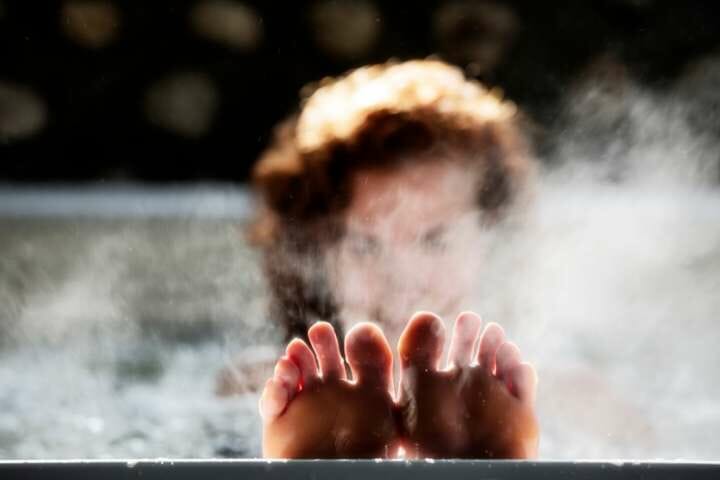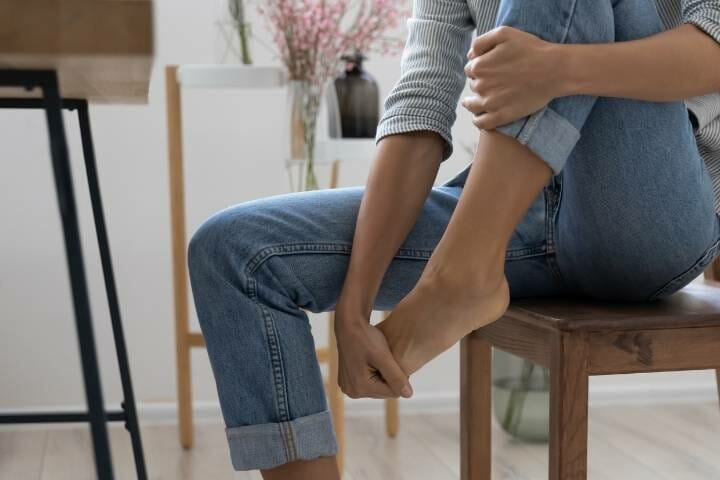For people living with restless leg syndrome it can feel like almost nothing really helps and they’re just doomed to be up all night, walking around.

The various treatments for restless leg syndrome may have different levels of effectiveness for each person, and it can be a series of trial and error to determine what works best for each person.
Many people living with restless leg syndrome have mentioned that having a hot bath before bed can help with the feelings of restlessness and discomfort.
So, is there any real proof that having a hot bath can help with restless leg syndrome? The short answer is yes – there has been research showing that a hot bath can really help.
Here’s what you’ll need to know.
Having a hot bath
Soaking in a hot bath before bed has numerous health benefits for many of us and it can really help us relax and fall asleep – especially if we’ve had a stressful day.
For people living with restless leg syndrome, it can also really help them out. The hot water helps to relax the overactive and overstimulated nerves. These nerves are overstimulated, and that is what causes the pain and discomfort
Soaking in the hot water gives relief to these nerves and helps them relax, which in turn will then help you fall asleep easier at night.
What about using a hot tub?
Many people have a hot tub for their personal use in their home, and if you have restless leg syndrome soaking in it daily can be really helpful.
If you have a mild form of this condition, you may only need to soak occasionally to get the relief you need. However, for those who have a more severe form of the condition they may need to soak for 20 minutes, or more, daily.

A hot tub would be the same as soaking a hot bath, too. So depending on which one you have access to either can help give you the relief you’re looking for.
How does the hot water help with restless leg syndrome?
The hot water helps to relieve stress and improve someone’s sleep. When someone is stressed out or is having trouble sleeping these are major triggers for the symptoms of restless leg syndrome.
The hot water and the jets (if you have them) can help you to relax and ease the tension. In some cases when the tension is high or someone is stressed out the symptoms of this condition can seem like they are so much worse or become more unbearable.
On top of that, the hot water helps to improve the circulation in your body – including your legs. With improved circulation people have reported a soothing feeling for achy leg muscles or those pins and needles feeling people with this condition feel.
As a bonus, you can use the jets (if you have them) to massage your legs. Massages feel really good for people with this condition and it helps to ease the symptoms they’re feeling.
Stretching after a hot bath
Once you’ve had a soak in a hot bath or hot tub, it’s the ideal time to stretch your legs out.
Take some time – maybe 20 minutes or so – after you’ve had a soak to stretch your legs or go for a little walk. While your legs are warm and relaxed, stretching can help to maximize the relief felt from the soak instead of just getting out of the tub and going right to bed.
If you’re wondering what type of exercises you can do, here are a couple suggestions for exercises that can be helpful for those living with restless leg syndrome
- In a sitting position, point and flex your toes – one leg at a time. Hold each position for about 20 seconds at a time. Repeat 3 – 5 times for each leg.
- Also in a sitting position, pull your knee to your chest until you feel a little stretch in your hamstring. Hold this stretch for about 20 seconds, and then switch to the other leg.
- In a standing position, you can stretch your calves by standing flat on your feet and then raising up to the balls of your feet. Repeat the motion several times.
Be careful not to over stretch. While stretching does feel good, and it can be really helpful for people who have restless leg syndrome, if you are over stretching then it can be harmful to your muscles and it may even trigger the symptoms. Be careful about stretching and making sure that you’re stretching properly.
How do you know if you have restless leg syndrome?
Everyone can get a little twitch or muscle ache in their legs once in a while, that’s very normal. However, if you have the urge to get up and walk around at night and can’t seem to settle in to fall asleep consistently then there might be a bigger issue.

The symptoms of this condition may come and go, but they are usually the worst for most people at night when they’re trying to go to sleep or after they’ve been sitting for an extended period of time.
The symptoms to look for when it comes to restless leg syndrome could be
Discomfort in the legs
Many people describe it as uncomfortable or painful sensations in their legs. It could feel like itching, pulling, creeping, burning or throbbing. Most people experience these sensations when they are trying to go to sleep at night, but they can also happen when someone has been inactive for a while.
Need to move around
This discomfort being felt is often only relieved by getting up to walk around so people with these symptoms often feel an uncontrollable urge to keep walking around so they feel better.
Disrupted sleep
When people have restless legs they often need more time to fall asleep and may wake up often, being disturbed by twitching legs or the need to walk around.
Feeling exhausted during the day
When you have trouble falling asleep at night, or staying asleep, it can cause you to feel exhausted during the day. This means you may not be able to function properly at work or make you feel like you’re wandering around in a fog.
This cycle can repeat itself, and make you more exhausted, when you can’t sleep well for multiple nights in a row. Trying to reduce the symptoms with soaking in a hot tub or regular exercise can help you to get better sleep at night.
Other ways to reduce the symptoms of restless leg syndrome
Besides soaking in a bath tub or a hot tub there are a few things people with restless leg syndrome can do to make sure their symptoms are minimized and they are able to fully settle at night.
Avoid alcohol
Alcohol is a stimulant and it can really magnify the symptoms of this condition – especially the twitching. Some people with restless leg syndrome completely avoid alcohol all the time while others will just only have one or two drinks every once in a while so that they don’t feel the effects of the alcohol as much.
Eat a balanced diet
Some people with restless leg syndrome have been known to have low iron levels, and so maintaining a diet that has sufficient levels of iron is important.
Additionally, eating a diet that’s balanced with lots of fresh produce and lean meats will help lessen the symptoms or the severity of the symptoms experienced.

In some cases people have reported that taking magnesium supplements have helped with their symptoms even though there isn’t yet a clear answer as to exactly how it helps or why it works.
Make sure you have a regular sleep schedule
When your sleep schedule is sporadic, it can make your restless legs feel worse or exacerbate the symptoms. By going to bed at the same time each night and waking up at the same time it can do a lot to regulate your sleep and help with the quality of sleep you have.
Try to avoid a lot of caffeine
Doctors have said that if someone has a really severe case of restless leg syndrome then avoiding caffeine will likely not make a difference in the symptoms their experiencing.
However, with the more mild cases of this condition then there is some proof that avoid caffeine can really help lessen their symptoms and make it easier to settle their legs, or avoid the urge to get up and walk around.
In summary
Having a soak in a hot bath or using a hot tub when you have restless leg syndrome can go a long way to helping relax your legs and allowing you to get a good night sleep.
You don’t have to soak for a long time – even just 20 minutes at night can really help you out. Follow the soak by some light stretching to help give you long-term relief of your symptoms.
Hot water relaxes your muscles and helps to settle the over stimulated nerves – which is what gives the twitching or tingling feeling of restless leg syndrome.
If you’re having troubles with getting your legs to settle at night, try having a hot bath before bed to help you relax.
